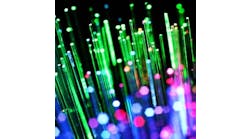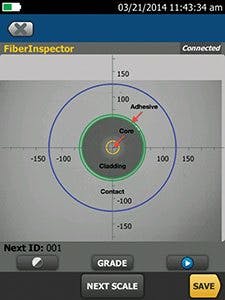Latest from FTTx/Optical Networks
Choosing a FTTH Network Architecture
Data Center Interconnect
OSP Engineering
Why You Should Fear Dirt!
by: Harley Lang and Carolyn Carter
This Article originally ran in the June 2014 issue of OSP Magazine)
Human nature is conditioned to find intrigue and excitement from solving mysteries through deductive reasoning. We’re ingrained from an early age by tales of Sherlock Holmes, Nancy Drew, and even Scooby Doo.
It’s no surprise that this carries on to our professional lives as network engineers, technicians, and administrators. We find intrigue in every network performance issue, immediately rounding up the usual suspects for deduction via an internal checklist of common causes and personal experiences. A call that the network is running slow sparks immediate hypotheses ranging from the mundane application delays, misconfigured priorities, and lost performance due to retransmission, to the titillating possibilities of sabotage through overheated servers and mice chewing through cables.
Unfortunately, there is often disparity between perception and reality. The most common cause is also the most overlooked, and often the last thing checked.
One recent customer survey* found that contaminated end-faces were the leading cause of fiber links, failing 85 percent of the time. Let that sink in for a bit. Dirt and debris cause 85 percent of network fiber link failures.
While inspecting and cleaning fiber end-faces and connectors is not new, it is growing in importance as links with increasing data rates are driving decreasing loss budgets. The increasing popularity of virtualization in data centers also means there will be more fiber connectors used in today’s network architectures.
Any dirty connector can significantly impact the performance of applications running over that link. With less tolerance for overall light loss, the attenuation through adapters must get lower and lower. Proper inspection and cleaning is absolutely critical.
Luckily, there is no reason to be worried by these tighter loss budgets because inspecting and cleaning connections is straightforward and easy.
As you know, fiber optic cabling carries data as pulses of light between transmitters and receivers. For the data to be transmitted successfully, the light must arrive at the far end of the cable with enough power to be measured. Light loss during transmission can come from multiple sources, such as the attenuation of the fiber itself, fusion splices, bending losses, and loss through adapter couplings where end-faces meet.
In lower data rate networks with shorter lengths, loss budgets may be generous enough to allow significant attenuation throughout the link, but the link will still function properly. However, as the need for perpetually greater bandwidth drives companies to push for higher data rates, loss budgets get correspondingly smaller and require all loss threats to be minimized.
Know Thy Enemy
Among key issues that can cause loss and bring a fiber network down, dirty and damaged end-faces are the most common and most underestimated threat. Nevertheless, there continues to be a lack of appreciation for this crucial issue along with lots of misinformation and improper techniques.
Network professionals need to know what to look for when evaluating end-face conditions. There are 2 types of problems that will cause loss as light leaves one end-face and enters another inside an adapter: contamination and damage.
Enemy 1: Contamination
Contamination comes in many forms from dust to oils to buffer gel. Simply touching the ferrule will immediately deposit body oil on the end-face and cloud the fiber end-face. Dust and small static-charged particles float through the air and can land on any exposed termination. This can be especially true in facilities undergoing construction or renovation, and new installations often fall victim to buffer gel and pulling lube finding their way onto an end-face.
Ironically, protective caps — a.k.a. "dust caps" — are another common form of contamination for 3 reasons:
- These caps are made in high-speed production processes that use mold release compounds that will contaminate end-faces on contact.
- The plasticizers deteriorate as the plastic cap ages, resulting in an outgas residue that can accumulate on the end-face.
- Airborne dust itself will find its way into the protective cap and will move to the end-face when the cap is pushed onto a ferrule.
Any of the 3 can nullify our false assumption that end-faces are clean, even when patch cords or pre-terminated pigtails are removed from a sealed bag with protective caps in place. Network professionals must inspect the end-face to verify that no contaminants are present.
The most crucial area to clean is the core of the fiber, followed by the cladding. However, contamination on the ferrule, outside of the end-face, could slide toward the core as the fiber is mated or handled. (See Figure 1.) Because of this, all connector elements should be inspected with any visible contamination removed if possible.
Figure 1. Inspect all connector elements for visible contamination.
Enemy 2: Damage
Deciding to mate every connection first and then inspecting only those that fail is risky. This is because the physical contact of mated contaminants can cause permanent damage, such as scratches, pits, cracks, or chips, that requires more costly and time-consuming retermination or replacement of pre-terminated links.
Regardless of the cause, damage must be evaluated to determine what course of action is required. For example, it is common for as much as 5 percent of the outer edge of fiber cladding to be chipped as a result of the polishing process. This amount of damage can generally be ignored, but any chips on the core are unacceptable. If scratches or excess epoxy bleed is found, repolishing with fine lapping paper can eliminate the problem. If the end-face is cracked or shattered, then the fiber must always be reterminated.
In every instance, all end-faces should always be inspected before insertion. If a connector is being mated to a port, then the port should be inspected as well. Inspecting one side of a connection is ineffective as contamination inside a port can not only cause damage but also migrate to the connector being inserted.
Detection With Fiber Microscopes
Microscopes have been used to inspect end-faces since the early days of fiber optic cabling. Historically, bench top microscopes were modified to handle this in manufacturing environments. Over time, new microscopes were designed specifically for the task, shrinking in size so that handheld units could be taken down the hall to the cabling closet or outside into the field.
Modern microscopes can be divided into 2 basic groups: optical and video. Optical microscopes incorporate an objective lens and an eyepiece lens to allow you to view the end-face directly through the device. Today, barrel-shaped microscopes are ubiquitous in termination kits and are used to inspect patch cords during troubleshooting. Price is often the best feature of these microscopes as they can be the least expensive way to see and inspect end-face details. Their drawback is that they are unable to view end-faces through bulkheads or inside equipment. As a result, you will sometimes hear these microscopes referred to as patch cord scopes.
Video microscopes incorporate both an optical probe and a display for viewing the probe’s image. Probes are small and can reach ports in hard-to-access places. The screens allow images to be expanded for easier identification of contaminants and damage. Because the end-face is viewed on a screen instead of directly, probes minimize the chance of injury from harmful laser light reaching a person’s eye.
What matters most about a microscope is what it shows the user. The goal is to identify all contaminants and damage of a minimum size and within a critical area. The first step is to identify the appropriate minimum size contaminant or defect that will affect your system. The smallest-sized item that a microscope can detect is referred to as its detection capability.
Next, look for the microscope that has the largest field of view while also maintaining the necessary detection capability. Unfortunately, detection capability and field of view require a trade-off as improving on one dimension tends to require a detriment to the other.
As a natural detective, you may be asking yourself how detection capability and field of view can be so important if magnification is the prevalent metric. Relying on magnification is not uniform across microscope types. Magnification is perfectly applicable to optical microscopes as performance is a direct function of the objective and eyepiece lens inside the device. Where magnification becomes less applicable is in video microscopes where the size of the image is a function of both the magnification of the lens as well as the size of the screen.
Further complicating matters is the effect of contrast on detection capability. Magnification specifications for video microscopes carry over from the historical prevalence of optical microscopes. Although magnification is directly related to detection capability, it is a less precise measure of a fiber microscope’s capabilities than detection capability and field of view.
The big challenge turns out to be the subjective view of the observer. A good detective may know what is good enough. But oftentimes it is time consuming to decide which pits, chips, scratches or dirt are ok. This is especially a problem when creating a perfectly clean and defect free end-face may take repeated cleanings. Fortunately there is a standard for what is acceptable for each region of the fiber end-face and fiber inspection equipment that will quickly determine pass/fail status.
Many network testing devices now incorporate fiber end-face inspection and analysis functionality, including the FI-7000 FiberInspector Pro from Fluke Networks. These devices feature intuitive screens for contaminant and damage inspection coupled with more advanced testing for a wide array of network troubleshooting applications.
Practicing Good Cable Hygiene
By now, you should be starting to understand that dirt is bad for fiber optic cable connectors. You should also know what and how to look for dirt, debris, and damage during inspections. Let’s move on to everyone’s favorite pastime: cleaning. There are a wide variety of tools and methods available. The 2 universally accepted forms include dry cleaning and solvents.
Method 1: Dry Cleaning
Traditionally, dry cleaning has proven to be only partially effective in eliminating contaminants from fiber end-faces and connectors. Most dry cleaning materials are either not good enough to uplift the various types of dirt or greasy contaminants over fiber end-faces, or they can actually introduce static to the fiber ferrule that attracts more dust than before the cleaning started.
Technological advancements and better dry cleaning materials have introduced a new class of fiber cleaning tools that are cost effective and efficient in cleaning more thann 50 percent of fiber contaminants. The most basic are wipes and swabs used to clean patch cords and inside ports. More involved physical approaches include mechanical, hand-held contraptions designed to make easier work of wiping the end-face clean.
A common dry cleaning approach is cleaning end-faces with canned air, either on a connector or inside a port. While canned air may seem effective, it is actually ineffective and can do more harm than good. Canned air is effective only on 1 type of contaminant: large dust particles. It cannot effectively clean oils, residues, or small, charged dust particles. Also, canned air tends to blow large particles around inside ports rather than carefully remove them. This simply moves the contamination and gives it an opportunity to migrate to more harmful areas.
Dry cleaning tools can be a perfect complement to solvents to cover cleaning in almost any application or environment. The key criterion for dry cleaning materials is that they are lint free and non-scratching — shirtsleeves are unacceptable, so don’t get any ideas.
Method 2: Solvents
Some contaminants, like greasy and sticky materials, are difficult to uplift without the use of a wet solvent. Solvents provide multiple benefits, the most important being their ability to dissolve dried contaminants adhered onto the end-face. Solvents also envelop particles and debris and effectively lift them from the ferrule surface so that they can be carried away without damaging the end-face.
Effective solvents also prevent a static charge from developing during dry cleaning, which can be particularly frustrating. There are many stories of end-faces becoming statically charged during solvent-free cleanings. The developed charge can be so strong that static dust accumulates on the end-face during the short move from a microscope into port, negating any actual benefit from the cleaning.
The cabling industry has used isopropyl alcohol (IPA) for years to successfully clean end-faces. However, there are now specially formulated solvents for fiber end-face cleaning that are far superior and more effective than IPA at dissolving virtually every contaminant. With a specified lower surface tension, the specialized solvents do a better job of enveloping debris for removal and will dissolve non-ionic compounds, which IPA will not.
When cleaning inside ports, evaporation rates become important as lingering solvents can become trapped during mating and create a harmful residue over time. Fiber-specific solvents have tailored evaporation rates that give them time to work yet disappear before mating. IPA is highly hygroscopic, which means it will actually draw moisture from the air and onto the end-face. This water mixes with the IPA and leaves a residue if it dries on the end-face. To be safe, leave the IPA in the medicine cabinet.
More complex cleaning methods and devices incorporate blasted solvents or ultrasound in water to achieve the best cleaning results. While more complex systems may achieve better results, they cost far more money.
Find Your Best Practice
With an evolving knowledge base, the cabling industry has moved toward new best practices. Certain truisms apply to fiber optic end-face inspection and cleaning no matter which option is selected, including:
- Inspection must occur not only before, but also after cleaning to ensure a good result. If a post-cleaning inspection shows remaining contamination, then a second cleaning must follow.
- Both sides of any connection must be inspected as every mating involves 2 surfaces coming into contact.
- It is almost always easier and cheaper to inspect and clean as a preventive measure than as a reactive response. Consistent inspection and cleaning up front will avoid unexpected and costly downtime in the future.
Knowing the most common cause of fiber link connection errors should help evolve your list of usual suspects for network performance issues. Following these tips should help reduce network performance mysteries and intrigue to child’s play.
Endnote:
*Fluke Networks customer survey of 200 contractors and network owners in North America. Results compiled 2001.
Harley Lang is Director of Marketing at Fluke Networks. He has nearly 20 years of experience in fiber optics and cabling technology. He can be reached via email at [email protected].
Carolyn Carter is Fiber Product Manager at Fluke Networks. She has more than 20 years of experience in electronics and telecommunications. She can be reached via email at [email protected].





